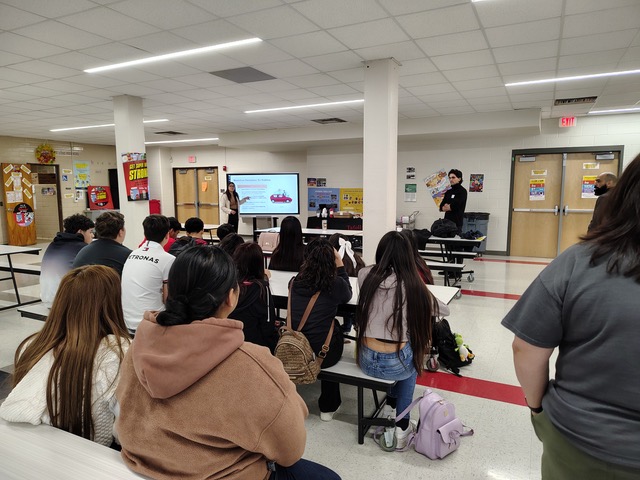
How To Prepare for Immigration Raids in the New School Year
About 4.4 million children who were born in the United States have at least one parent who is undocumented. The Pew Research Center estimates that 733,000 school-age children are undocumented. School districts are not permitted to collect information about students’ immigration status, and schools used to be protected spaces. But in February, the Trump administration rescinded protected-area policies. Now, immigration agents can enter schools, churches, and other protected spaces.
We talked with three experts: Trudy Taylor Smith, senior administrator of policy and advocacy at the Children’s Defense Fund of Texas; Viridiana Carrizales, CEO and co-founder at ImmSchools; and Esmeralda Alday, senior director of partnerships and impact with ImmSchools, an organization that works in various districts across the United States to support immigrant families and children. How are schools preparing for potential immigration raids this school year, and what should teachers know?
What has happened so far?
Since the second Trump administration started, ImmSchools lawyers and advocates have received daily reports of parents being detained, entire families moving back to countries that children have never visited, and U.S. citizens or mixed-status families being affected. “The impact is very real,” says Alday, “and we support parents and schools with this daily.”
It’s not something that experts like Alday anticipated. “Everybody understood that things were going to be different this time around,” she told We Are Teachers, “but people were surprised at how quickly the deportations happened.”
Heading into the new school year, one thing that’s new is the Big Beautiful Bill. The funding act, passed on July 1, 2025, includes substantial funding increases for immigration enforcement and deportations. This means that immigration enforcement may accelerate this school year, says Smith. So far, immigration raids have not taken place on school grounds. But without protective status, immigration officials can enter schools. This means that this school year could see even more pressure on schools as students and their families respond to potential immigration raids.
“There was a big shock at the beginning,” says Carrizales, “and a lot of uncertainty” for districts. Many sought support from ImmSchools—the organization received many more inquiries this year than they have in the past. But as one school year has turned into the next, districts are more cautious about partnering because of uncertainty around funding and the political climate.
Heading into this school year, the big concern is still attendance. Back-to-school communication may look different this year as schools make a concerted effort to connect with families who may be reluctant to return to school.
What does the recision mean?
First, the recision of protected status doesn’t mean that there are no limits. Constitutional protections still apply, Smith told We Are Teachers, and immigration agents do require a judicial warrant to enter a private space. Still, there is a legitimate concern that ICE agents may enter schools or wait outside schools to deport families as they arrive to pick up their kids from school.
All this creates fear. “Even though we haven’t seen really frequent instances of ICE descending on a school and conducting raids in the hallways,” says Smith, “just the acknowledgement that the policy changed has created a lot of fear.” That fear may keep students who do not have citizenship or who live in mixed-status families—families in which some members are citizens and others are not—absent from school.
How are districts preparing?
The main focus this year, as it was last year, is on student attendance. The goal is to maintain enrollment, says Alday, to support students and ensure that funding matches a school’s student population.
As the 2025-26 school years starts, district leaders across the country are preparing to train administrators and teachers:
What can teachers do?
Responding to immigration raids looks different at the classroom, school, and district levels. Here’s what teachers and school leaders should know and can do this school year.
First, know the school policies.
This is always good advice. Families and students have rights, like their right to attend school. Knowing those rights makes teachers better prepared to advocate for families and to push back if anyone demands information or actions that go against federal law.

Teachers should know the policies that are in place if ICE enters a school. Law enforcement must show and verify their identification, says Smith. If ICE agents have a warrant, that warrant may need to be shared with the district. Smith suggests having a designated person on campus who is responsible for referring any visitors and verifying their requests so you don’t have to make the decision of whether to allow them in or not.
Use FERPA to your advantage.
All teachers should know that the federal privacy law, FERPA, prevents schools and teachers from giving out student information. Even if a federal official requests information, schools cannot give out information without violating FERPA protocols.
Review student records.
Make sure that student records do not have any unnecessary information, says Smith. Student records should not have their immigration status or even where they were born. Parents should know when school directory information is public and have a chance to update their information.
Update emergency contact lists.
One of the biggest concerns, says Alday, is what to do if a parent is detained and the student’s emergency contact list is not up-to-date. District enrollment and community partnership offices can reach out to parents often and make sure their emergency contact lists are up-to-date and that they include friends or neighbors who could provide support.
Prepare students.
Teachers of older students can teach students what to look for if a federal official comes to their door, and how to speak to federal officials. Knowing phrases in English that they can use, and knowing the difference between various types of officials (the local police compared to an immigration official) or what different types of warrants look like, can help students make the right decision in the moment.

Small actions go a long way to build trust with families. First, be aware of local service providers to help parents set up and manage guardianship agreements of power of attorney in case they are detained. If a student’s parent is detained, connect with the district McKinney-Vento office to support them with housing.
Alday suggests finding out how the parents in your community communicate. Many families will follow WhatsApp groups more consistently than emails, SMS texts, or a school LMS.
Ensure language access.
“Language access right now is more important than ever,” says Alday. Learn your students’ home languages and download a translation app that will help you communicate effectively with their families.
Consider the broader impacts.
Be aware that because of racial profiling, U.S. citizen children may be on edge when they see people who look like them being deported. “It’s important to recognize that there may be a lot of fear in the room,” says Smith. “This is a traumatizing thing for all of our children to be growing up in, but especially for children who may be at risk because of their race.”
Learn more: What Is Trauma-Informed Teaching?
Resources for K-12 Teachers and Schools
Many thanks to Children’s Defense Fund for this comprehensive list. Visit their website for more info.
Resources from the AFT, NILC, and CLASP
These fact sheets provide information on how schools can protect student privacy, restrict ICE enforcement, and support students and families impacted by enforcement.
More Resources
These resources have been updated since January 2025:
Looking for more articles and resources like this? Be sure to subscribe to our newsletters to stay informed about education news.
Source link



